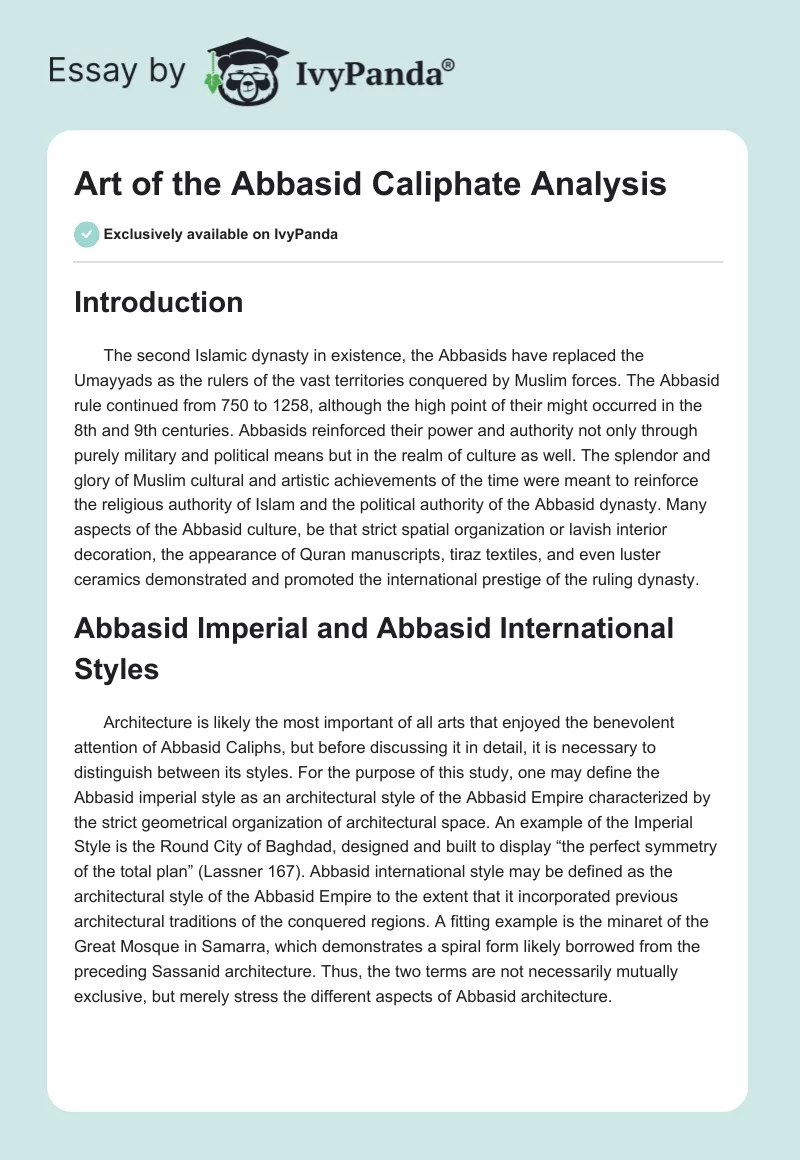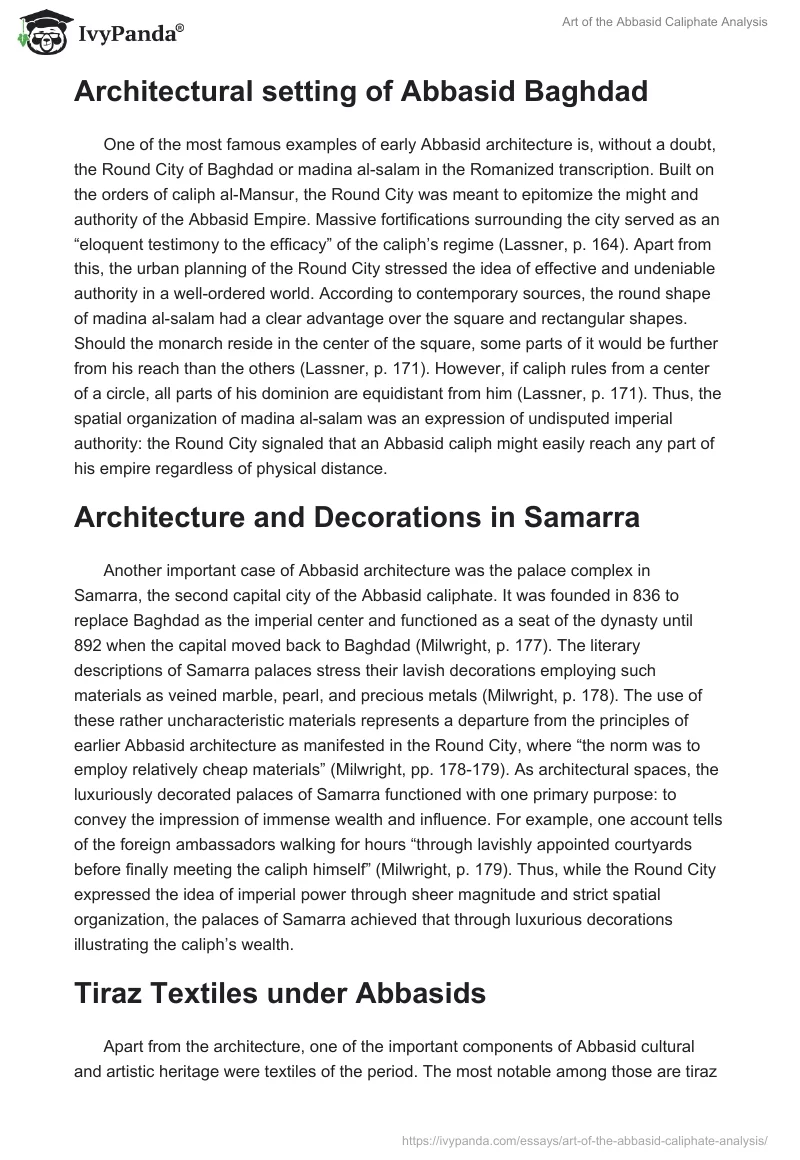Introduction
The second Islamic dynasty in existence, the Abbasids have replaced the Umayyads as the rulers of the vast territories conquered by Muslim forces. The Abbasid rule continued from 750 to 1258, although the high point of their might occurred in the 8th and 9th centuries. Abbasids reinforced their power and authority not only through purely military and political means but in the realm of culture as well. The splendor and glory of Muslim cultural and artistic achievements of the time were meant to reinforce the religious authority of Islam and the political authority of the Abbasid dynasty. Many aspects of the Abbasid culture, be that strict spatial organization or lavish interior decoration, the appearance of Quran manuscripts, tiraz textiles, and even luster ceramics demonstrated and promoted the international prestige of the ruling dynasty.
Abbasid Imperial and Abbasid International Styles
Architecture is likely the most important of all arts that enjoyed the benevolent attention of Abbasid Caliphs, but before discussing it in detail, it is necessary to distinguish between its styles. For the purpose of this study, one may define the Abbasid imperial style as an architectural style of the Abbasid Empire characterized by the strict geometrical organization of architectural space. An example of the Imperial Style is the Round City of Baghdad, designed and built to display “the perfect symmetry of the total plan” (Lassner 167). Abbasid international style may be defined as the architectural style of the Abbasid Empire to the extent that it incorporated previous architectural traditions of the conquered regions. A fitting example is the minaret of the Great Mosque in Samarra, which demonstrates a spiral form likely borrowed from the preceding Sassanid architecture. Thus, the two terms are not necessarily mutually exclusive, but merely stress the different aspects of Abbasid architecture.
Architectural setting of Abbasid Baghdad
One of the most famous examples of early Abbasid architecture is, without a doubt, the Round City of Baghdad or madina al-salam in the Romanized transcription. Built on the orders of caliph al-Mansur, the Round City was meant to epitomize the might and authority of the Abbasid Empire. Massive fortifications surrounding the city served as an “eloquent testimony to the efficacy” of the caliph’s regime (Lassner, p. 164). Apart from this, the urban planning of the Round City stressed the idea of effective and undeniable authority in a well-ordered world. According to contemporary sources, the round shape of madina al-salam had a clear advantage over the square and rectangular shapes. Should the monarch reside in the center of the square, some parts of it would be further from his reach than the others (Lassner, p. 171). However, if caliph rules from a center of a circle, all parts of his dominion are equidistant from him (Lassner, p. 171). Thus, the spatial organization of madina al-salam was an expression of undisputed imperial authority: the Round City signaled that an Abbasid caliph might easily reach any part of his empire regardless of physical distance.
Architecture and Decorations in Samarra
Another important case of Abbasid architecture was the palace complex in Samarra, the second capital city of the Abbasid caliphate. It was founded in 836 to replace Baghdad as the imperial center and functioned as a seat of the dynasty until 892 when the capital moved back to Baghdad (Milwright, p. 177). The literary descriptions of Samarra palaces stress their lavish decorations employing such materials as veined marble, pearl, and precious metals (Milwright, p. 178). The use of these rather uncharacteristic materials represents a departure from the principles of earlier Abbasid architecture as manifested in the Round City, where “the norm was to employ relatively cheap materials” (Milwright, pp. 178-179). As architectural spaces, the luxuriously decorated palaces of Samarra functioned with one primary purpose: to convey the impression of immense wealth and influence. For example, one account tells of the foreign ambassadors walking for hours “through lavishly appointed courtyards before finally meeting the caliph himself” (Milwright, p. 179). Thus, while the Round City expressed the idea of imperial power through sheer magnitude and strict spatial organization, the palaces of Samarra achieved that through luxurious decorations illustrating the caliph’s wealth.
Tiraz Textiles under Abbasids
Apart from the architecture, one of the important components of Abbasid cultural and artistic heritage were textiles of the period. The most notable among those are tiraz textiles – the inscribed textiles most commonly but not exclusively found in the Islamic burial of Abbasid Egypt (Sokoly, p. 275). These inscriptions generally refer to official commissions by Islamic rulers or their representatives and, as a result, contain a wealth of “religious, dynastic, administrative, and historical context” (Sokoly, p. 276). This information reveals much about the functioning of the Abbasid Empire as a highly centralized monarchy. For instance, they illustrate the pivotal importance of “placing the caliph’s name in official inscriptions” (Sokoly, p. 278). As a result, for those producing and using them, tiraz textiles were a source of political legitimacy. Due to this fact, the separatists who rebelled against the Abbasid rule aimed, among other things, to establish control over the production of tiraz textiles (Sokoly, p. 278). Thus, just as the architecture, the textiles of the Abbasid period served to strengthen the dynasty and reinforce its authority – unless a separatist attempted to usurp their production for their own goals.
Quran Manuscripts under Abbasids
Yet another essential aspect of the Abbasid art was the decoration of Quran manuscripts. Decorating the holy book of Islam was one of the most significant cultural enterprises possible, so it should be no surprise that such an important medium also revealed the political aspirations of the Abbasids. A characteristic example of Quran decoration in Abbasid time is Blue Quran featuring a golden script on the dark blue pages. While the combination of gold on dark blue was already known in earlier Islamic art, the Umayyads mainly used it for mosaic inscriptions (George, p. 97). While the idea of Umayyads producing the first gold-on-blue Qurans is conceivable, it lacks any factual foundation and, thus, remains purely speculative (George, p. 97). Hence, Abbasids were likely the first ones to order Qurans in this color scheme, which was a direct manifestation of their ambitions. Under the Umayyads, this color code “gradually came to acquire a royal connotation,” and using it to decorate Quran emphasized the unity of supreme secular and religious authority in the figure of caliph (George, p. 103). Thus, the color scheme of Quran decoration under the Abbasids once again reveals their far-reaching imperial ambitions.
Luster Ceramics under Abbasids
One more part of the Islamic art of the Abbasid period was the characteristic luster ceramics. Its production techniques were invented and refined in Iraq during the 9th century and testify to the artistic innovativeness of the Abbasid caliphate. The first step in producing luster ceramics is coating earthenware vessels with opaque white glaze, then firing them and leaving them to cool (Saba, p. 190). After that, one should apply “pigments composed of diluted metallic oxides” to the vessel’s surface over the glaze and then fire the vessel in a kiln a second time (Saba, p. 190). One of the widely accepted explanations of the lusterware production in Abbasid Iraq is cultural appropriation: historians have theorized that Iraqi masters have imitated Chinese porcelain (Saba, p. 190). If this is the case, it means that the reach of the caliphate extended far to the East, and the Abbasid Empire maintained commercial and diplomatic relations with China.
International Trade of the Abbasid Caliphate
Ceramic lusterware is not the only evidence of the Abbasid caliphate engaging in international trade. Arab merchants traveled far and wide, as demonstrated by the impressive range of foreign goods adopted in the Abbasid cultural landscape. Imports largely came from the East, as in the case of the above-mentioned Chinese porcelain (Saba, p. 190). Apart from that, Abbasid Caliphate was familiar with indigo dye, which could only have been imported from India (George, pp. 96-97). Additionally, the eggplant, which is a staple of Muslim cuisine nowadays, was also an Indian import in Abbasid times (Perry, p. 3). Thus, many aspects of Islamic art and culture demonstrate that the Abbasid caliphate actively engaged in international trade, mostly with the countries of the East.
As one can see, the art of the Abbasid period is always connected to the imperial majesty of the caliphate in one way or another. The architecture of the Round City in Baghdad emphasized the inescapable reach of the caliph’s power, while the elaborate and lavish decorations of Samarra displayed the monarch’s enormous wealth. The inscribed tiraz textiles underlined the central role of the caliph in the Muslim world and functioned as a source of legitimacy for the dynasty. Using gold and blue – a color scheme with profound regal connotations – for Quran decoration stressed the unity of secular and religious authority embodied by the caliph. Even the lusterware ceramics, likely borrowed from China, was an indirect testimony of the empire’s influence since only a great power could maintain international trade over such distances.
References
- George, Alain. “Calligraphy, Colour and Light in the Blue Qur’an.” Journal or Qur’anic Studies, vol. 1, no. 1, 2009, pp. 75-125.
- Lassner, Jacob. The Shaping of Abbasid Rule. Princeton UP, 2017.
- Milwright, Marcus. “Samarra and Abbasid Ornament.” A Companion to Islamic Art and Architecture, vol. I: From the Prophet to the Mongols, edited by Finbarr Barry Flood and Gülru Necipoglu, John Wiley & Sons, 2017, pp. 177-196.
- Perry, Charles. “Cooking with the Caliphs.” Saudi Aramco World, vol. 57, no. 4, 2006, pp. 1-7.
- Saba, Matthew D. “Abbasid Lusterware and the Aesthetics of ʿAjab.” Muqarnas: An Annual on the Visual Cultures of the Islamic World, vol. 29, 2012, pp. 187-212.
- Sokoly, Jochen. “Textiles and Identity.” A Companion to Islamic Art and Architecture, vol. I: From the Prophet to the Mongols, edited by Finbarr Barry Flood and Gülru Necipoglu, John Wiley & Sons, 2017, pp. 275-299.


